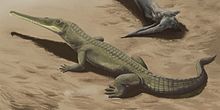Phytosaurs are an extinct group of large, mostly semiaquatic Late Triassic archosauriform reptiles. Phytosaurs belong to the order Phytosauria. Phytosauria and Phytosauridae are often considered to be equivalent groupings containing the same species, but some studies have identified non-phytosaurid phytosaurians. Phytosaurs were long-snouted and heavily armoured, bearing a remarkable resemblance to modern crocodilians in size, appearance, and lifestyle, as an example of convergence or parallel evolution. The name "phytosaur" means "plant reptile", as the first fossils of phytosaurs were mistakenly thought to belong to plant eaters.

Revueltosaurus is an extinct genus of suchian pseudosuchian from Late Triassic deposits of New Mexico, Arizona and North Carolina, United States. Many specimens, mostly teeth, have been assigned to Revueltosaurus over the years. Currently, three species are included in this genus, all of which were originally thought to represent monospecific genera of basal ornithischian dinosaurs. It was 1 meter long.

The Chinle Formation is an Upper Triassic continental geological formation of fluvial, lacustrine, and palustrine to eolian deposits spread across the U.S. states of Nevada, Utah, northern Arizona, western New Mexico, and western Colorado. In New Mexico, it is often raised to the status of a geological group, the Chinle Group. Some authors have controversially considered the Chinle to be synonymous to the Dockum Group of eastern Colorado and New Mexico, western Texas, the Oklahoma panhandle, and southwestern Kansas. The Chinle Formation is part of the Colorado Plateau, Basin and Range, and the southern section of the Interior Plains. A probable separate depositional basin within the Chinle is found in northwestern Colorado and northeastern Utah. The southern portion of the Chinle reaches a maximum thickness of a little over 520 meters (1,710 ft). Typically, the Chinle rests unconformably on the Moenkopi Formation.
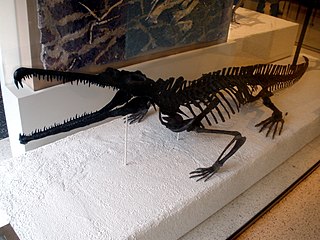
Rutiodon is an extinct genus of mystriosuchine phytosaurs from the Late Triassic of the eastern United States. The type species of Rutiodon, Rutiodon carolinensis, encompasses a large number of skulls and assorted postcranial fossils discovered in the Cumnock Formation of North Carolina. Fossils referable to the species are also known from Pennsylvania, New Jersey, and Virginia. Rutiodon carolinensis is the most well-described species of phytosaur in eastern North America, though its validity as a natural taxon has been questioned. Some paleontologists also recognize a larger and more robust species, Rutiodon manhattanensis, which is known from teeth and postcranial fossils from New Jersey and Pennsylvania.

Nicrosaurus (/nɛkroʊˈsɔrəs/) is an extinct genus of phytosaur reptile existing during the Late Triassic period. Although it looked like a crocodile, it was not closely related to these creatures, instead being an example of parallel evolution. The main difference between Nicrosaurus and modern crocodiles is the position of the nostrils – Nicrosaurus's nostrils, or external nares, were placed directly in front of the forehead, whereas in crocodiles, the nostrils are positioned on the end of the snout. A 2013 study has also found that ilium of Nicrosaurus is quite distinctive from all other phytosaurs.
Redondasaurus is an extinct genus of phytosaur from the Late Triassic of the southwestern United States. It was named by Hunt & Lucas in 1993, and contains two species, R. gregorii and R. bermani. It is the youngest and most evolutionarily-advanced of the phytosaurs.
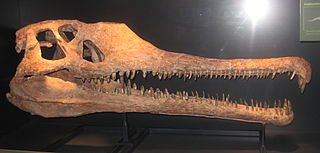
Angistorhinus is an extinct genus of phytosaur known from the Late Triassic period of Texas and Wyoming, United States. It was first named by Mehl in 1913 and the type species is Angistorhinus grandis. Other species from Texas and Wyoming, A. alticephalus, A. gracilis and A. maximus, are cospecific with the type species. Angistorhinus is known from the holotype UC 631, partial skull and lower jaws recovered from the Popo Agie Formation, Chugwater Group, Wyoming and from the associated paratype UM 531, a partial skull, TMM 31098-1, skull and lower jaws and ROM 7977, partial skull and lower jaws, recovered from the 'Pre-Tecovas Horizon' in the Dockum Group, Texas. A possible second species, A. talainti is known from the Triassic of Morocco. In 1995, Long and Murry created the new combination, Angistorhinus megalodon by synonymy for Brachysuchus. Hungerbühler and Sues (2001) hypothesised that Angistorhinus is a junior synonym of Rutiodon. However, in 2010 Michelle R. Stocker retained the validity of Brachysuchus and of A. grandis.
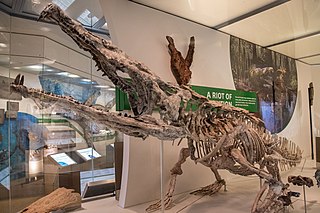
Smilosuchus is an extinct genus of leptosuchomorph parasuchid from the Late Triassic of North America.

Mystriosuchini, historically known as Pseudopalatinae, is an extinct tribe of derived phytosaurs in the clade Leptosuchomorpha. As with all other phytosaurs, mystriosuchins lived during Late Triassic. The name is derived from the genus Mystriosuchus.

Leptosuchus is an extinct genus of leptosuchomorph phytosaur with a complex taxonomical history. Fossils have been found from the Dockum Group and lower Chinle Formation outcropping in Texas, New Mexico, and Arizona, USA, and date back to the Carnian stage of the Late Triassic.

Machaeroprosopus is an extinct genus of mystriosuchin leptosuchomorph phytosaur from the Late Triassic of the southwestern United States. M. validus, once thought to be the type species of Machaeroprosopus, was named in 1916 on the basis of three complete skulls from Chinle Formation, Arizona. The skulls have been lost since the 1950s, and a line drawing in the original 1916 description is the only visual record of the specimen. Another species, M. andersoni, was named in 1922 from New Mexico, and the species M. adamanensis, M. gregorii, M. lithodendrorum, M. tenuis, and M. zunii were named in 1930. Most species have been reassigned to the genera Smilosuchus, Rutiodon, or Phytosaurus. Until recently, M. validus was considered to be the only species that has not been reassigned. Thus, Machaeroprosopus was considered to be a nomen dubium or "doubtful name" because of the lack of diagnostic specimens that can support its distinction from other phytosaur genera. However, a taxonomic revision of Machaeroprosopus, conducted by Parker et al. in 2013, revealed that UW 3807, the holotype of M. validus, is not the holotype of Machaeroprosopus, while the species Machaeroprosopus buceros, Machaeroprosopus being a replacement name, with a fixed type species, for Metarhinus, is the combinatio nova of the type species of the genu: Belodon buceros. Therefore, the name Pseudopalatus must be considered a junior synonym of Machaeroprosopus, and all species of the former must be reassigned to the latter. This revised taxonomy was already accepted in several studies, including Stocker and Butler (2013). Stocker and Butler (2013) also treated M. andersoni as a valid species, and not a junior synonym of Machaeroprosopus buceros as was previously suggested by Long and Murry (1995).
Pravusuchus is an extinct genus of leptosuchomorph parasuchid phytosaur known from the Late Triassic of Arizona, United States. It contains a single species, Pravusuchus hortus, which is known from three specimens. These specimens were previously referred to Smilosuchus or to Leptosuchus, but Pravusuchus's autapomorphy, its phylogenetic position as well as a trait shared with mystriosuchins, justified the erection of a new taxon for the material.
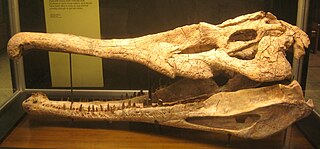
Brachysuchus is an extinct genus of phytosaur known from the late Triassic period of Dockum Group in Texas, United States. It is known from the holotype UMMP 10336 is composed of a skull, lower jaws and partial postcranium and from the associated paratype UMMP 14366, nearly complete skull, recovered from the 'Pre-Tecovas Horizon' in the Dockum Group. It was first named by Case in 1929 and the type species is Brachysuchus megalodon. Its closest relative was Angistorhinus. However, its rostral crest was much smaller than that of Angistorhinus, and the rostrum as a whole is shorter and thicker.
Acallosuchus is an extinct genus of reptile from the Triassic Chinle Formation of the southwestern United States. Although it was discovered in 1923, Acallosuchus was not described until 1995, when the type species A. rectori was named. The taxonomy classification of Acallosuchus is uncertain. Although it is known to be a neodiapsid reptile, it has not been assigned with confidence to any particular group of neodiapsids.

Leptosuchomorpha is a clade of phytosaurs. It is a node-based taxon defined as the last common ancestor of Leptosuchus studeri and Pseudopalatus pristinus and all of its descendants.
Wannia is an extinct genus of basal phytosaur reptile known from the Late Triassic of Texas, southern United States. It contains a single species, Wannia scurriensis, which is known from a single specimen. This species was originally named as a species referred to Paleorhinus and later was considered as a possible junior synonym of Paleorhinus bransoni. However its re-description revealed five autapomorphies, and a phylogenetic position as the most basal known phytosaur, justifying the erection of a new generic name for the species.

Rugarhynchos is an extinct genus of doswelliid archosauriform from the Late Triassic of New Mexico. The only known species is Rugarhynchos sixmilensis. It was originally described as a species of Doswellia in 2012, before receiving its own genus in 2020. Rugarhynchos was a close relative of Doswellia and shared several features with it, such as the absence of an infratemporal fenestra and heavily textured skull bones. However, it could also be distinguished by many unique characteristics, such as a thick diagonal ridge on the side of the snout, blunt spikes on its osteoderms, and a complex suture between the quadratojugal, squamosal, and jugal. Non-metric multidimensional scaling and tooth morphology suggest that Rugarhynchos had a general skull anatomy convergent with some crocodyliforms, spinosaurids, and phytosaurs. However, its snout was somewhat less elongated than those other reptiles.
Puercosuchus is an extinct genus of archosauromorph reptile from the Late Triassic (Norian) of what is now Arizona, North America. It includes only the type species P. traverorum, and was described and named in 2022. Puercosuchus is known mainly from two bonebeds in the Blue Mesa Member of the Chinle Formation, preserving the mixed remains of multiple individuals in each one representing almost the entire skeleton. It is a member of the Azendohsauridae, a clade of Triassic reptiles that was initially recognised by adaptations for herbivory. However, Puercosuchus and its close relatives in the subclade Malerisaurinae retained the carnivorous diet and body form ancestral to archosauromorphs. Unlike non-malerisaurine azendohsaurids, Puercosuchus had a long and shallow snout with sharp, blade-like teeth similar to those of carnivorous dinosaurs. Despite its seemingly ancestral morphology and ecology, Puercosuchus is the youngest known genus of azendohsaurid in the world. The discovery of Puercosuchus allowed palaeontologists to recognise similar bones and teeth that had been collected from Late Triassic southwestern North America in the past as belonging to it or similar animals, acting as a sort of "rosetta stone" for malerisaurine azendohsaurid anatomy.
Colossosuchus is an extinct genus or large mystriosuchine phytosaur from the Upper Triassic Tiki Formation of India. It was among the largest known phytosaurs, reaching a length of over 8 m (26 ft). Among its characteristic features are the dome-shaped head and downturned tip of the upper jaw. Colossosuchus was part of an endemic radiation of phytosaurs from India, closely related to two additional forms not yet named. The genus is monotypic, only including the species Colossosuchus techniensis.
